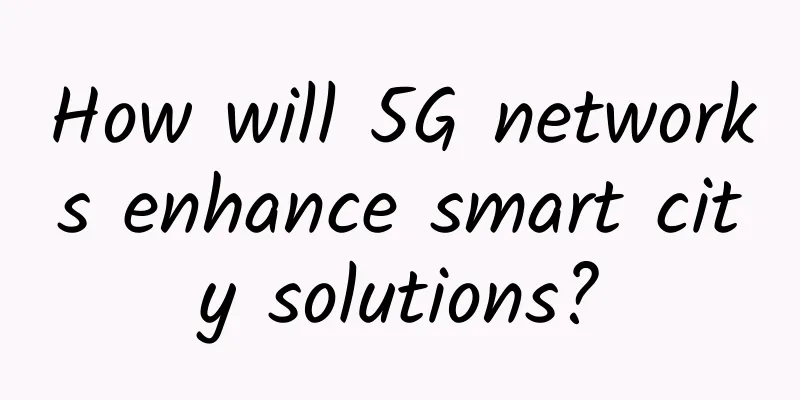How will 5G networks enhance smart city solutions?

|
The idea of a smart city evokes specific images in people’s minds, whether it’s the 60s cartoon The Jetsons or a dystopian future similar to that depicted in the Blade Runner series. While there are no flying cars or glass tubes beckoning people to work, the reality is that smart cities are already here, operating behind the scenes in surprisingly practical but valuable ways. Smart cities use advances in digital technologies, such as the Internet of Things, to improve the quality of life of residents, save energy, and reduce emissions. As 5G wireless networks become more widespread and mature, smart city capabilities will rapidly increase. Everything from vehicles, public transportation, water and traffic management, public safety and green technology to IoT connectivity will experience tremendous innovation with the advent of 5G. 5G will improve intelligent transportation systems Autonomous and connected vehicles already have impressive capabilities, such as detecting objects in their path and braking when necessary. Equipped with 5G, these vehicles will become even safer and more common. Through 5G communications, artificial intelligence will have the ability to make split-second decisions about roads and intersections. Smart cities also plan to build networks of connected cars so that self-driving cars can "talk" to each other and receive instructions to avoid congested areas and prevent accidents. Connected cars using 5G also have the potential to benefit the environment. Many expect the rise of autonomous vehicles and ride-sharing services to lead to a reduction in personal vehicle ownership. Additionally, connected vehicles will be primarily electric, requiring smaller motors, thereby reducing the use of fossil fuels. As the main mode of transportation in cities, public transportation can also benefit from 5G networks through real-time and end-to-end visibility. Residents who rely on buses, subways and light rail will get where they need to go faster and more safely through "trip-level intelligence" and fleet monitoring. In addition, their overall travel experience will be improved through advanced Wi-Fi connectivity and in-vehicle communications are improved, as well as secure toll collection and mobile ticketing. Benefits of 5G for Smart Water and Transportation Infrastructure The main goal of smart cities is to optimize existing infrastructure. For example, 5G will help smart cities accurately monitor water management and make adjustments when necessary, such as checking for leaks. Cities use an incredible amount of water, but much of it is wasted during leaks. The United States loses approximately 1.7 trillion gallons of water each year due to leaks. Additionally, infrastructure leaks cause the average city anywhere in the world to lose 20% to 40% of its drinking water each year. Smart cities are looking to use 5G-based smart water monitoring devices to track and detect leaks early so that water authorities can resolve the problem immediately. With 5G, water monitoring devices can leverage information faster and provide actionable insights into where, when, and how leaks occur. In addition to monitoring leaks, smart cities can also use sensors installed on river banks to monitor flooding. After upgrading to 5G, the accuracy and speed of predicting floods will increase. Cities can also deploy automated systems to give residents more clarity on their water usage and provide them with ways to save water. Another major infrastructure issue that smart cities address is transportation. Often, transportation issues, such as untimely lights, are caused by transportation agencies’ reliance on outdated schedules and technology. By strategically placing 5G-connected technologies such as sensors and cameras throughout the city, a central location running on an AI system can send and receive information about traffic patterns in real time. This AI system can then inform traffic lights to adjust their timing and eliminate unnecessary stops to ensure that traffic flows smoothly. With 5G, smart cities can make better decisions about how to direct traffic and where road and parking improvements are needed. These solutions are often inexpensive compared to the problems they solve and can save costs. 5G can help cities make residents safer Smart cities are using 5G not only to solve transportation and infrastructure issues, but also to enhance the safety of residents. Smart cities can develop strategies to address a range of goals, including earthquake early warning and damage assessment, flood relief, and homelessness data modeling. With the help of 5G, cities may one day be able to achieve these goals. Similarly, smart cities plan to use 5G capabilities to generate alert systems that notify pedestrians’ phones if a dangerous or suspicious vehicle is approaching. They can use a combination of innovative software and security cameras to determine where gunshots are coming from so criminals can be arrested quickly. Several other smart cities have different applications that enable residents to report potholes and issues with city infrastructure and communicate with city officials. The effectiveness of these applications and software will only grow with the development of 5G in the future. 5G enables green technology for a cleaner environment The final fundamental aspect of any smart city is its commitment to energy conservation and emission reduction. With the rollout of 5G, the application of green technology in cities and their environmental projects will directly increase. By enabling real-time transmission of data, better design, and sophisticated algorithms, 5G will help smart cities and smart buildings move toward net-zero emissions, reduced energy consumption, and cleaner air. Green technology would not be possible without wireless communications; it is essential for monitoring industrial tank levels and chemical emissions. 5G enables the management and automation of green technologies such as solar panels, precision agriculture, and street lighting. Smart cities also plan to use 5G through sensors. Initially, these devices will monitor air quality, sound pollution and public trash can levels. Smart cities using green technologies are already achieving impressive results, including a 10% to 15% reduction in greenhouse gas emissions, 30 to 130 kg of solid waste reduction per person per year, and 25 to 80 liters of water savings per person per year. The future benefits of green technology will be enormous; researchers predict that by 2030, 5G networks will produce 85% fewer emissions per unit of data transmitted compared to existing cellular networks. Smart cities are already making life better for their residents, and with the implementation of 5G, their achievements will finally turn yesterday’s science fiction into tomorrow’s possibility. |
<<: Matter is about to be launched. What surprises will it bring to the smart home market?
>>: How 5G precision timing will change our automated world
Recommend
Understanding Internet Protocol Security — IPSec
IPSec (Internet Protocol Security) is a security...
What happens when you enter a URL in the browser (Part 2): TCP module encapsulation and transmission mechanism
This series of articles will start with an introd...
Why are unlimited data plans dying?
Regardless of whether it was a unified arrangemen...
Huawei: "Intelligent Distributed Access Network" creates true gigabit high-quality life experience
On October 15, Huawei held a press conference tit...
On the Importance of Redundant Backup in Data Centers
It is a commonplace to say that data centers need...
Patents and standards proposals complement each other to start the battle for 5G commanding heights
Thanks to the contributions of national policies,...
Sharktech: 1Gbps unlimited traffic server starting at $79/month, Los Angeles & Denver data centers, 60Gbps high defense
Sharktech has no special offers recently, but has...
5G+Industrial Internet, making manufacturing "smart" is no longer a dream
Exploring new paths for industrial development [[...
Transmission technology has made a great leap forward! The IoT market will exceed one trillion this year
Multiple IoT transmission technologies have been ...
HostKvm New Year Promotion: 30% off Hong Kong International/Los Angeles VPS, 20% off other data centers
HostKvm also released a promotional plan for the ...
In the 5G era, what else can we sell besides traffic?
According to official news, 5G will be put into c...
Good news for 5G! China ranks first in the world in 6G patents, and many countries are investing heavily to catch up
As a developing country, China's internationa...
Ultra-low energy consumption Passive Wi-Fi speed exceeds 11Mbps
According to foreign media reports, a research te...
Authoritative release: Ten major events in China's industrial Internet in 2020
In order to comprehensively display the developme...
Fearing that 5G deployment will affect aviation safety! US aviation agencies and telecommunications agencies are in dispute
Although 5G (fifth-generation mobile communicatio...









